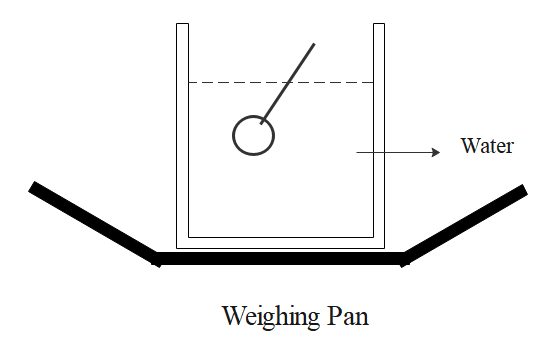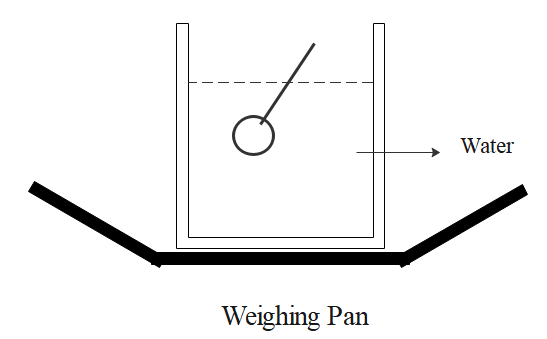Answer
384k+ views
Hint: Calculate the volume of the ball given and then find out the weight of it. Then, add it up with the existing weight. Also, the mass of the pin is negligible, neglecting the weight of it in the total measurement. Weight and mass are not the same.
Formula used:
$d=\dfrac{m}{v}$
Complete answer:
Let us assume the density of the given ball is $d$, the mass of the ball as $m$and the volume of the ball as $v$. Now, the volume of the ball must be calculated,
$\begin{align}
& d=\dfrac{m}{v} \\
& v=\dfrac{m}{d} \\
& v=\dfrac{40}{0.80} \\
& v=50c{{m}^{3}} \\
\end{align}$
Now, the total weight must be calculated in the following way,
total weight =
$\begin{align}
& 600+50 \\
& 650 \\
\end{align}$
Therefore, the weighing pan will display as $650$, option c.

Additional information:
The weight of an object is the force of gravity on the object and maybe defined as the mass times the acceleration of gravity. As weight is a force, the SI unit of the weight is Newton. The density of a substance is its mass per unit volume. For a pure substance, the density has the same numerical value as its mass concentration. The density can be related to buoyancy, purity and packaging.
Note:
As mass is given in the question, the weighing machine doesn’t display the value of given mass and existing value. There’s a difference between mass and weight. Weight is the mass times the gravity. So, instead, we can find the volume of the ball and add it to the existing value.
Formula used:
$d=\dfrac{m}{v}$
Complete answer:
Let us assume the density of the given ball is $d$, the mass of the ball as $m$and the volume of the ball as $v$. Now, the volume of the ball must be calculated,
$\begin{align}
& d=\dfrac{m}{v} \\
& v=\dfrac{m}{d} \\
& v=\dfrac{40}{0.80} \\
& v=50c{{m}^{3}} \\
\end{align}$
Now, the total weight must be calculated in the following way,
total weight =
$\begin{align}
& 600+50 \\
& 650 \\
\end{align}$
Therefore, the weighing pan will display as $650$, option c.

Additional information:
The weight of an object is the force of gravity on the object and maybe defined as the mass times the acceleration of gravity. As weight is a force, the SI unit of the weight is Newton. The density of a substance is its mass per unit volume. For a pure substance, the density has the same numerical value as its mass concentration. The density can be related to buoyancy, purity and packaging.
Note:
As mass is given in the question, the weighing machine doesn’t display the value of given mass and existing value. There’s a difference between mass and weight. Weight is the mass times the gravity. So, instead, we can find the volume of the ball and add it to the existing value.
Recently Updated Pages
How many sigma and pi bonds are present in HCequiv class 11 chemistry CBSE

Why Are Noble Gases NonReactive class 11 chemistry CBSE

Let X and Y be the sets of all positive divisors of class 11 maths CBSE

Let x and y be 2 real numbers which satisfy the equations class 11 maths CBSE

Let x 4log 2sqrt 9k 1 + 7 and y dfrac132log 2sqrt5 class 11 maths CBSE

Let x22ax+b20 and x22bx+a20 be two equations Then the class 11 maths CBSE

Trending doubts
Fill the blanks with the suitable prepositions 1 The class 9 english CBSE

At which age domestication of animals started A Neolithic class 11 social science CBSE

Which are the Top 10 Largest Countries of the World?

Give 10 examples for herbs , shrubs , climbers , creepers

Difference between Prokaryotic cell and Eukaryotic class 11 biology CBSE

Difference Between Plant Cell and Animal Cell

Write a letter to the principal requesting him to grant class 10 english CBSE

Change the following sentences into negative and interrogative class 10 english CBSE

Fill in the blanks A 1 lakh ten thousand B 1 million class 9 maths CBSE




